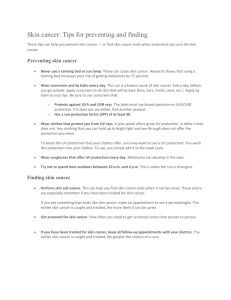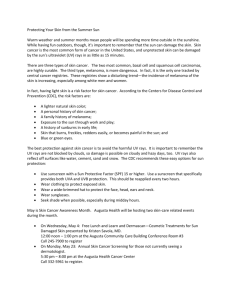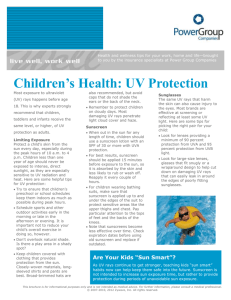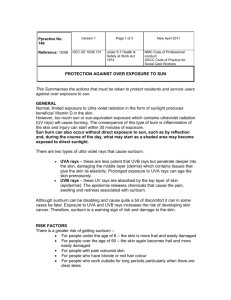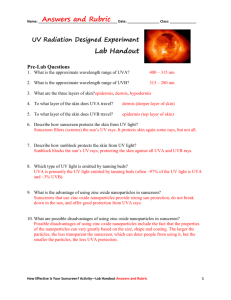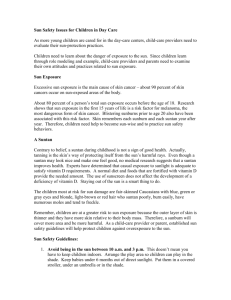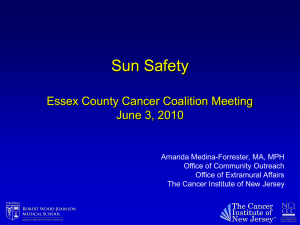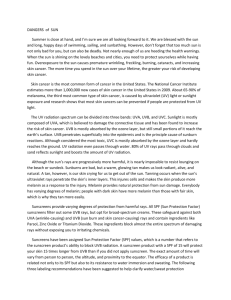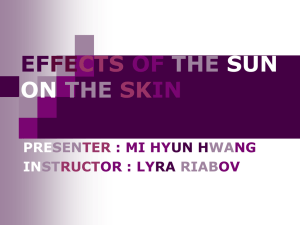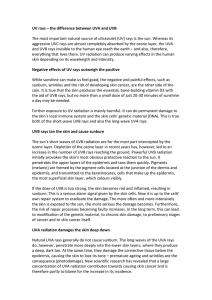Skin cancer statistics - Outdoor Media Association
advertisement
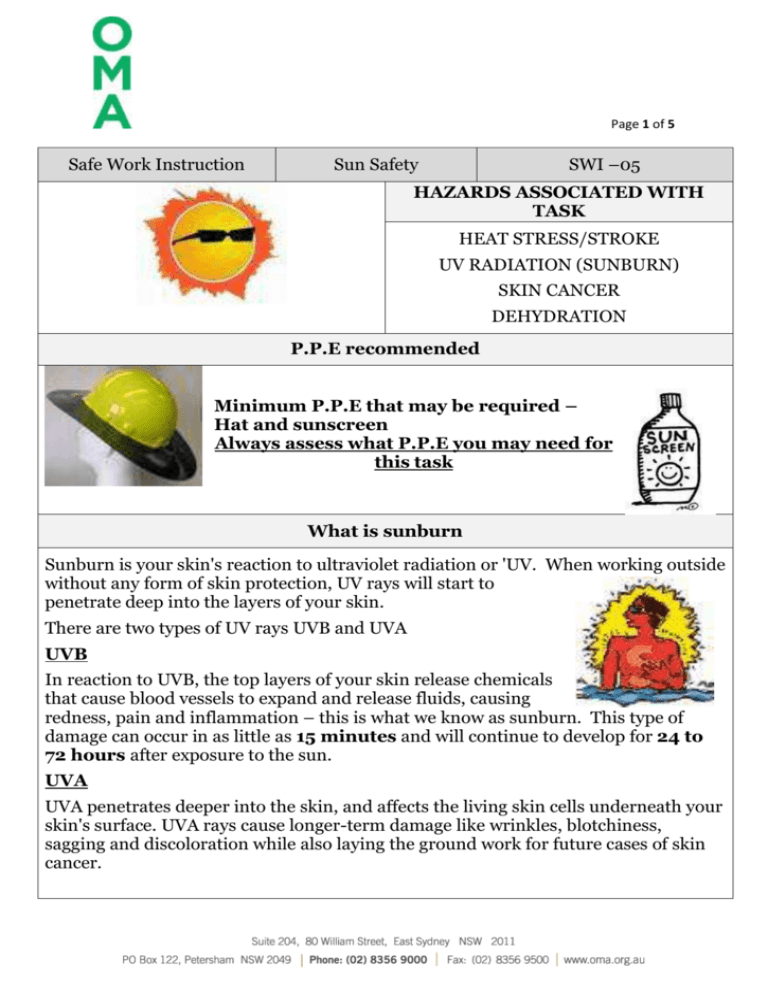
Page 1 of 5 Safe Work Instruction Sun Safety SWI –05 HAZARDS ASSOCIATED WITH TASK HEAT STRESS/STROKE UV RADIATION (SUNBURN) SKIN CANCER DEHYDRATION P.P.E recommended Minimum P.P.E that may be required – Hat and sunscreen Always assess what P.P.E you may need for this task What is sunburn Sunburn is your skin's reaction to ultraviolet radiation or 'UV. When working outside without any form of skin protection, UV rays will start to penetrate deep into the layers of your skin. There are two types of UV rays UVB and UVA UVB In reaction to UVB, the top layers of your skin release chemicals that cause blood vessels to expand and release fluids, causing redness, pain and inflammation – this is what we know as sunburn. This type of damage can occur in as little as 15 minutes and will continue to develop for 24 to 72 hours after exposure to the sun. UVA UVA penetrates deeper into the skin, and affects the living skin cells underneath your skin's surface. UVA rays cause longer-term damage like wrinkles, blotchiness, sagging and discoloration while also laying the ground work for future cases of skin cancer. Page 2 of 5 Prevent sunburn and skin cancer Use a broad spectrum, water resistant SPF 30+ sunscreen – always try to apply the sunscreen at least 15 to 20 minutes before going out in the sun and reapply every two hours- if you are performing strenuous work then look at the thicker “sports” sunscreens Wear an appropriate hat (broad brimmed, bucket or legionnaire are suitable). If you wear a hard hat, there are shade attachments that can fit your hard hat, see your employer about getting these for you Wear safety rated sunglasses that meet the Australian Standard AS1067 and fit close to the face Wear appropriate clothing, collared sleeved shirts and trousers or long shorts below the knee Tight weave fabric such as cotton is recommended (generally is spark resistant) clothes with sleeves and a collar For more information contact The Cancer Council NSW Cancer Helpline on 13 11 20 Be sunsmart and save your skin Skin cancer statistics Australia has the highest rate of skin cancer in the world. Almost 1 in 2 people who live here their whole lives will develop some form of skin cancer. There are more than 1600 deaths from skin cancer in Australia every year. In NSW incidence and mortality rates for skin cancer are also high. Over 3500 new cases of melanoma are diagnosed every year and more than 460 people die. There are also some 147,653 new cases of non-melanoma skin cancers (squamous cell and basal cell carcinoma). Incidence and mortality are highest in people aged over 50 years. However melanoma also occurs in younger people. In 2005 in NSW, melanoma was the most common cancer in males aged 25-54 and in females aged 15-29. It was the second most common cancer in women 30-54 years of age. Referenced from the Cancer Council N.S.W Page 3 of 5 When should I have my skin spots checked? Self checking for any changes to your skin You should check your own skin regularly, say every three months. Keep a record of the dates you check your skin and make notes about anything you're keeping an eye on. If you are concerned about anything you should get your skin seen by a general practitioner When you have a: New spot that is different from other spots around it Spot, mole or unusual freckle that has changed in shape, size, or colour Sore that doesn't heal Skin spot that you are worried about If you are worried about anything you can: See a General Practitioner (GP) Your own GP is the best person to see because he or she knows your full history, and can examine your skin and advise you regarding appropriate care Referenced from the Cancer Council N.S.W What is dehydration Dehydration is defined as the lack of water in the body. The human body can last for weeks without food, but it can only last for a few days without water. Roughly 60% of the human body is water. It is contained in blood plasma, muscle tissue, fat tissue, bones and teeth. Dehydration can set in at anytime - while out installing signs or just working in the warehouse. By the time you feel thirsty, you are already dehydrated. Water acts as a temperature regulator for the body. Due to its role in the functioning of the human body, a significant lose of water can be very critical if left unattended. There are many indicators that can help you to detect dehydration. Signs and Symptoms: (listed in order of severity from least to most) thirst impatience fatigue Page 4 of 5 nausea lack of concentration increased pulse and respiration dizziness laboured breathing mental confusion kidney failure Failure to address dehydration can lead to more dangerous effects on the body such as heat cramps and heat stroke CONTROL MEASURES Drink plenty of fluids on hot days Drink plenty of water (small amounts over a long period) Drinks that contain alcohol and caffeine should NOT be taken because they may interfere with the body's ability to regulate a constant temperature. DO NOT use salt tablets or salt water. Page 5 of 5 XXX Company Staff Sign off I, the undersigned have read and understood the Sun Safety instructions and the general safety controls that are recommended when I am involved in any Sun Safety task. I also understand that I should ensure that I have sunscreen available and must request more sunscreen from my employer if I have not got any or have used the sunscreen I have been issued with each time I will be working outdoors. Name Signature Name 1. 2. 3. 4. 5. 6. 7. 8. 9. 10. 11. 12. 13. 14. 15. 16. 17. 18. 19. 20. Signature
